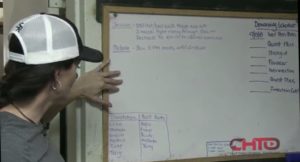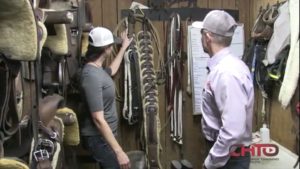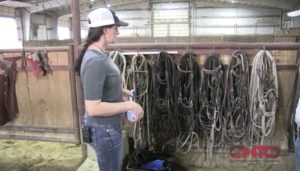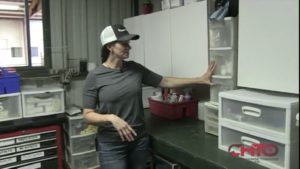 A well-run barn is the key to any smooth operation. Whether you have one or 50 horses in your care, it’s crucial that you have an organized space, know where everything is and are able to act in any kind of emergency.
A well-run barn is the key to any smooth operation. Whether you have one or 50 horses in your care, it’s crucial that you have an organized space, know where everything is and are able to act in any kind of emergency.
Kellee Clarke has been the barn manager for Slate River for nine years and counting. She makes sure everything has its place, and most importantly gets put back in place. Her feed room, vet room, tack room and stalls are clearly labeled so almost anyone can walk in and know just what to do for any of the horses.
➤ Not only does having a system save money, it keeps the work flow efficient and it keeps horses safer and healthier.
Clarke said it helps her stay up to date on each horse from deworming schedules to farrier visits and feed changes.
Whiteboards
Don’t be skimpy on whiteboards. Clarke has a whiteboard in every section of the barn. They keep track of meds, horses worked or to be worked, horses shod, deworming, feed, rehab plans and so much more.
“I’m really big on whiteboards. The information is there for someone if I got sick and couldn’t come to work. They can come to the whiteboard.”
For the tack room whiteboard, Clarke said that when they have new employees she will number the saddle racks and write a number by the horse on a whiteboard. Having a number system keeps it simple so everyone knows what saddle goes on what horse.
She will also write down the order horses are getting worked, who is getting exercised, who is going to a show, who is going on the hot walker, who doesn’t go in the pasture and a to do list of chores.
On the saddling area whiteboard, Clarke has Sunday chores listed, a pasture drawing for a turnout schedule, horse’s farrier dates, what horses get iced. The staff write down what horse went on the walker and at what time so no one gets missed.
In the vet room, Clarke writes down her deworming rotation schedule and what medications any horse may be on.
She also adds the rehab plan for any horses that need it. She has a list for horses receiving scratches treatment and Back On Track boots or other therapies horses may be receiving.
Tack Care

Tip: Hang the cinches on a latigo to keep them organized!
Clarke has clean cinches attached to a latigo so they are easy to access everyday. Equipment must be well cared for to ensure comfort for the horse and functionality.
Clarke also makes sure that the latigos are oiled regularly. If a latigo breaks, needless to say, it could be a disaster in the show pen. It’s on Clarke’s list of ‘to do’s’ all the time, she or her team will go through and brush olive oil on the latigos about once a week in the summer.
“Before you know it, your latigo is gone. It just takes them drying out a little bit. And if you just check those holes and when you see the slightest little tear in the leather, it’s got to go. It’s not safe anymore.”
“We can double the life of a latigo just by keeping them lightly oiled,” said Clarke.
Slate River keeps the bridles they use daily in one spot. The snaffles, corrections, Buster’s, loping bridles and hackamores are sorted into different sections and pegs.
In between every horse, they spray each bit off with a mixture of Synbiont and water and hang it back up. Using a bridle is the best way to keep it soft and flexible. If something has been hanging on the hooks for awhile it will get dusty and moldy so the team will wipe the bridle down with clorox wipes and then wipe them down with an oily rag.
 “I find the clorox wipes work really good because they kill the mold,” Clarke said.
“I find the clorox wipes work really good because they kill the mold,” Clarke said.
Vet Room
“I like to keep it as organized as possible so anybody that walks in here can find what they need.”
Clarke has a cabinet with medications, a cabinet with wound care, leg sweats and like items.
➤ She also gives a handy tip: keep medications in paste form in a drawer.

Tip: Keep medications in paste form in a drawer.
“When I draw medication up, I don’t like to use the needle that I’m going to [give the medication to the horse]. A needle is one of the most important things. I use a bigger needle to draw the drugs up, it comes off and goes in the sharps container. I never use the same needle. It dulls it. Every time you stick the needle into something, the tip gets blunt.”
They keep every size syringe in a drawer from 1cc to 60ccs, Clarke finds that sometimes you need to be very accurate with medications such as Acepromazine (Ace).
Have gloves in your vet room. Some medications and leg sweats are not good for humans to get on their skin.
Clarke prefers to keep a separate stock of veterinary care items in the horse trailer so they can just load tack and horses and go to the show. She also keeps track of expiration dates and brings medications into the barn if they are about to expire to use it up.
➤ Watch Kellee’s video explaining her system in more depth Here!
